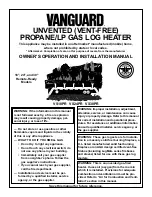
61
MAINTENANCE
Follow the service and maintenance procedures given throughout
this manual and in component literature shipped with the water
heater. Failure to perform the service and maintenance could
result in damage to the water heater or system. Failure to follow
the directions in this manual and component literature could
result in severe personal injury, death, or substantial property
damage.
The water heater should be inspected annually only by a qualified
service technician. In addition, the maintenance and care of
the water heater designated in Table 29 and explained on the
following pages must be performed to assure maximum water
heater efficiency and reliability. Failure to service and maintain
the water heater and system could result in equipment failure.
Electrical shock hazard – Turn off power to the water heater
before any service operation on the water heater except as noted
otherwise in this instruction manual. Failure to turn off electrical
power could result in electrical shock, causing severe personal
injury or death.
REVIEW WITH OWNER
1. Emphasize the need to perform the maintenance schedule
specified in this manual.
2. Remind the owner of the need to call a qualified service
technician should the water heater or system exhibit any
unusual behavior.
3. Remind the owner to follow the proper shutdown procedure
and to schedule an annual maintenance
4. Inspect any problems reported by the owner and correct
before proceeding.
INSPECT WATER HEATER AREA
1. Verify that water heater area is free of any combustible
materials, gasoline and other flammable vapors and liquids.
2. Verify that air intake area is free of any of the contaminants
listed on Page 14. If any of these are present in the water
heater intake air vicinity, they must be removed. If they
cannot be removed, reinstall the air and vent lines per this
manual and the XP water heater Service Handbook.
INSPECT WATER HEATER INTERIOR
1. Remove the front access cover and inspect the interior of
the water heater.
2. Vacuum any sediment from inside the water heater and
components. Remove any obstructions.
CLEAN CONDENSATE TRAP
1. Inspect the condensate drain line, condensate PVC fittings,
and condensate trap.
2. Remove the PVC cap retaining screw from the PVC cap
(Figure 76).
3. Remove the 2 inch PVC cap with the switch located at the
top of the trap (Figure 76).
4. Remove any sediment in the trap.
5. Fill with fresh water until the water begins to pour out of the
drain.
6. Replace the cap. Press the cap onto the trap until the cap
makes contact with the drain.
7. Replace the retaining screw.
Figure 76. Condensate Trap
The condensate trap must be filled with water during all times
of water heater operation to avoid flue gas emission from the
condensate drain line. Failure to fill the trap could result in severe
personal injury or death.
CHECK ALL PIPING FOR LEAKS
Eliminate all system or water heater leaks. Leaking water may
cause severe property damage.
1. Inspect all water and gas piping and verify to be leak free.
2. Look for signs of leaking lines and correct any problems
found.
3. Check gas line using the procedure found in Gas Connections
section on Page 42.
FLUE VENT SYSTEM AND AIR PIPING
1. Visually inspect the entire flue gas venting system and air
piping for blockage, deterioration or leakage. Repair any
joints that show signs of leakage. Verify that air inlet pipe is
connected and properly sealed.
2. Verify that water heater vent discharge and air intake are
clean and free of obstructions.
Failure to inspect for the above conditions and have them
repaired can result in severe personal injury or death.
CHECK WATER SYSTEM
1. Verify all system components are correctly installed and
operational.
2. Watch the system pressure as the water heater heats up
(during testing) to ensure pressure does not rise too high.
Excessive pressure rise indicates expansion tank sizing or
performance problem.
CHECK EXPANSION TANK
1. Expansion tanks provide space for water to move in and out
as the heating system water expands due to temperature
increase or contracts as the water cools. Tanks may be
open, closed or diaphragm or bladder type. See Water
Heater Installation section on Page 36 for suggested best
location of expansion tanks and air eliminators.








































